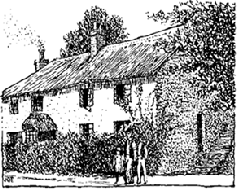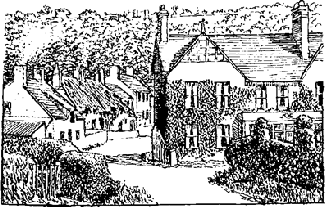





STOKE ST MARY AND DISTRICT HISTORY GROUP
HISTORY OF STOKE ST MARY
Only determined travellers, two centuries ago, found their way to the village of Stoke St. Mary. Main roads did not disturb it, and the single lane leading west to Taunton followed a difficult course across the Vale. Long isolation was finally ended early in the nineteenth century, when local roads were greatly improved. But even today the traces of a solitary and less thriving past have not entirely vanished: the thirteenth century parish church is small and simple to an exceptional degree, and the village street contains few of the large farmhouses which, elsewhere in the Vale, are a conspicuous feature.
Accidents of the soil explain much. Though the parish of Stoke St. Mary -
****
Man’s struggle with this varied landscape began many centuries ago: an unfinished Iron Age hill fort at Netherclay and scattered traces of Roman settlement are proof of that, and several local farms, including those at Broughton and Greenway, probably have very early origins. Only in the ninth century, however, did the landscape first enter the light of recorded history. A Saxon charter, dated about the year 854, tells how a West Saxon king called Aethelwulf gave lands at ‘Stoc’ to the minster church of Taunton, mother church of the Vale. The landmarks which defined the minster's new estate were carefully recorded, and included the 'halgan wylle', or holy spring, which still exists on Stoke Hill, and a great ditch which survives impressively on Stoke St. Mary's southern border.
The name borne by this small estate adds one detail to our knowledge of its early history. For the Old English word 'stoc’ usually described the cattle-
The minster had only enjoyed King Aethelwulf’s gift for 50 years when its growing estates were acquired by the Bishop of Winchester. For over 900 years his successor bishops were destined tc remain lords of what became the great manor of Taunton Deane, and the power at their command was soon reflected in the transformation of the Vale which they probably inspired. In Stoke St. Mary this transformation, which may have happened in the twelfth century, saw the partial replacement of a landscape of scattered farms by a village street lined with houses, set in the midst of large open fields farmed in common. The outline of one of those fields, later called Stoke Down, remains in fine completeness behind Stoke Farm, its grid of arable strips and access tracks fossilised by hedges dating from the late Middle Ages.
The Bishop's home farm in Stoke and Ruishton was worked from Haydon, where barns and granaries were filled through the efforts of his tenants and farm servants. His vineyard was close at hand, and on top of Stoke Hill, in an area near Stoke Hill Farm which is now open land, stood Knowl Wood, the largest and most important of all the Bishop's Somerset woodlands. (The slopes of Stoke Hill at this period were probably unwooded pasture.)
****
The landscape of the medieval village was made complete in the thirteenth century when the present stone-
A resident priest to serve both Ruishton and Stoke was provided by the prior following an agreement made in 1308. And though almost none of Stoke's medieval priests are known by name, their home, the 'priest's house', was a familiar part of the village until in 1963 it was demolished as unsafe.
It stood diagonally opposite the church, on a site acquired for the parish in 1452-

CHURCH HOUSE
John Stotte lived to see some cf the changes which, in the course of the sixteenth century, transformed the church from a place of Catholic worship to a setting for the services of the Anglican prayerbook. Far-
****
Throughout centuries of change, agriculture never ceased to be Stoke St. Mary's major occupation; but in the course of the seventeenth century, the cloth industry came to occupy a place hardly less important. Spinners and weavers, worsted-
Religious and political controversy, the echo of national events, took its place as another major element in the pattern of seventeenth century village life. When Thomas Pickering became curate in 1612, he was soon at odds with puritan members of his congregation, reporting in 1613 that several villagers preferred to hear puritan sermons in Taunton than to attend their parish church. He angrily denounced some of the rebels during one Sunday service, calling William Ellis a 'mased ideot'; but even when Ellis and other ringleaders had been excommunicated, they found a ready welcome at Thurlbear church from the more sympathetic curate, William Jennings.
The Puritans flourished locally, especially after the sufferings inflicted on Taunton by Royalist armies in the Civil War, and when monarchy was restored in 1660, thousands in the Vale were soon active dissenters from the Anglican Church. In 1669, up to 100 Presbyterians were gathering regularly to worship in Stoke St. Mary, numbering among their meeting-
****
Concerns more worldly than religion dominated the village in the eighteenth century. Members of the parish vestry, meeting by 1705 in Joan Booby's alehouse rather than the church, found themselves responsible not only for care of the church fabric, but for mending the roads and relieving the sick anc poor. In 1708, a payment of £1 3s 9d helped Joan Brown and her illegitimate daughter when they caught smallpox, and the following year there were regular payments to provide young Thomas Gully with 'scooling'. Edward Foord's illness in the winter of 1736 found the parish officers ready to provide joints of beef and mutton; and in 1737 they even supplied the necessary 2d to buy Andrew Phillpott a wedding ring.
Those who still troubled to make their way to St. Mary's church at this period found the village stocks to greet them in the churchyard, and a tiny white-
An Independent lor Congregational) chapel, built in 1825 on land given by John and Mary Weaver, was clear evidence of nonconformist revival in Stoke St. Mary after the fallow years of the eighteenth century. The new chapel drew large attendances, especially from labouring families in the parish, and in 1849 part of a congregation nearly 30C strong took to Stoke Woods to make the hills 'resound with their vocal choruses'. Anglican revival soon followed, and in Stoke St. Mary was marked especially by the appointment in 1860 of the saintly William Lance as curate. He undertook the restoration of Thurlbear Church in 1861, and in 1864 turned his attention to Stoke St. Mary, where the old church was thought too small for a growing population. Accordingly, a new south aisle was built. But the work of restoration did not end there, as a contemporary account records:
The whole of the 'pews' have been swept away and replaced, in the chancel by neat substantial oak stalls, and in the nave with open stained deal benches. The font has been reworked with sunk tracery panels, and that abomination of modern times, the singing gallery, removed.
The thirteenth century tower fortunately escaped a suggested rebuilding, but the eighteenth century chalice and paten were not so lucky: in 1872, they were replaced by a modern set of medieval design.
****
The character of Stoke St. Mary itself changed rapidly in th« early nineteenth century. As roads leading to the village were improved so its 'picturesque' attractions were discovert: by some prosperous tradesmen in the town. Among them were John Stephens, a linen-
New gentry also reached the parish to replace the ruined Burridges, farming squires of Stoke St. Mary for over 100 years. During the 1850s, Captain Thomas Patton, R.N. (no relation of the American general) acquired both Stoke House and Stoke Court, together with a large farming estate, and for the next 60 years his family's name was to be as closely linked with Stoke St. Mary as was the name of Portman with neighbouring parishes to the south. Captain Patton preferred to live at his mansion in Bishops Hull, but allowed Stoke House to be used by a succession of his children, including his son Colonel Henry Patton. As commander of the Volunteer Reserve, Colonel Patton achieved local fame for the mock battles he organised at Orchard Portman; and among his many services to the community, he became first chairman of the Parish Meeting in 1894, and first president of the Stoke St. Mary and Thurlbear Cricket Club, founded at the Half Moon one April evening in 1910.
While the Pattons lived at Stoke House, Stoke Court was let to tenants, notable among them Captain William Surtees Cook. He reached the village in May 1859 when the nightingales were singing 'all night long', and brought with him his wife Henrietta, favourite sister of Elizabeth Barrett Browning. Elizabeth was soon writing to ask news of them in their 'new paradise’, but learned in the following year of her sister's painful illness from cancer. Henrietta died in her husband's arms on 23 November 1860, and lies buried at his side in the churchyard at Thurlbear.
****
When Colonel Patton died in 1915, the villagers half recognised the end of an era, watching from their doorways one January dawn as the last squire of Stoke was carried to his grave. By the time the First World War was over, the village had also lost its butcher, Capel Drewe, and its blacksmith, George Trump, and was to suffer like most rural parishes from the farming depression which came in the aftermath of war. Population figures did not, as in some parishes, show rapid decline; but, even so, the 217 inhabitants recorded at Stoke St. Mary in 1931 were almost one hundred fewer than in the over-
The effects of the Second World War were more immediately felt. Late in 1939, evacuees from East and West Ham began to arrive, and in June 1940 the second of many bombs to be dropped on Somerset exploded near the Nag's Head. Much worse followed on 28 June 1941 when three parachute mines fell over Stoke St. Mary and Thurlbear, causing considerable damage to several buildings, including Stoke House, Greenway Farm, and Thurlbear Church. In October, two further mines fell at Ash Farm, on the eastern borders of the parish.
Renewed self-
Both in character and appearance, Stoke St. Mary has changed more rapidly in the last 20 years than at any time since the early nineteenth century. Gone forever is the close-
SOME VILLAGE HOUSES
Stoke St. Mary now bears the obvious signs of recent development, but contains as well much evidence of earlier building and rebuilding. Furse Cottage, a fine thatched house, stands at the heart of the village and is probably Stoke St. Mary's oldest domestic building: it rose in the sixteenth century and was evidently enlarged in 1658 by Thomas Furse, a lime-
The seventeenth century saw numerous other houses enlarged or rebuilt near the centre of the village, among them Higher Broughton Farm (originally called Stoke Farm), the Orchard, Tuckers, and Aplens, while at a greater distance rose Broughton Farm -
The striking Regency mansion called Stoke House is a more conspicuous feature of the hill. It was finished in about 1810 and owned successively by the Weaver, Harman and Patton families, local tradition recording that the horse chestnuts which line its former carriage drive commemorate the many children of Captain Thomas Patton.
His grandson, Henry Walsh, spent his childhood at Stoke House, and later gained distinction in the Zulu Wars, being the first to greet Major John Chard after the defence of Rorke's Drift. From the very top of the hill another early nineteenth century house looks out, built by the mildly eccentric Samuel Stodgell, a prosperous limeburner. He called his new home Stoke Castle, but generations of disrespectful locals thought 'Jack Straw's Castle' a better name.
Notable among Victorian houses in the village is the Cedars, for long a property of the Maine family. It had been built by 1886 and replaced a seventeenth century house whose kitchen survives as Meadow Cottage.
The Half Moon, sole survivor of the three pubs which Stoke St. Mary possessed 80 years ago, reached its present form in the village street at the very end of the nineteenth century, evidently following a destructive fire: traces of an elegant brick built predecessor are still visible in the present structure.

THE VILLAGE STREET
GO TOP
